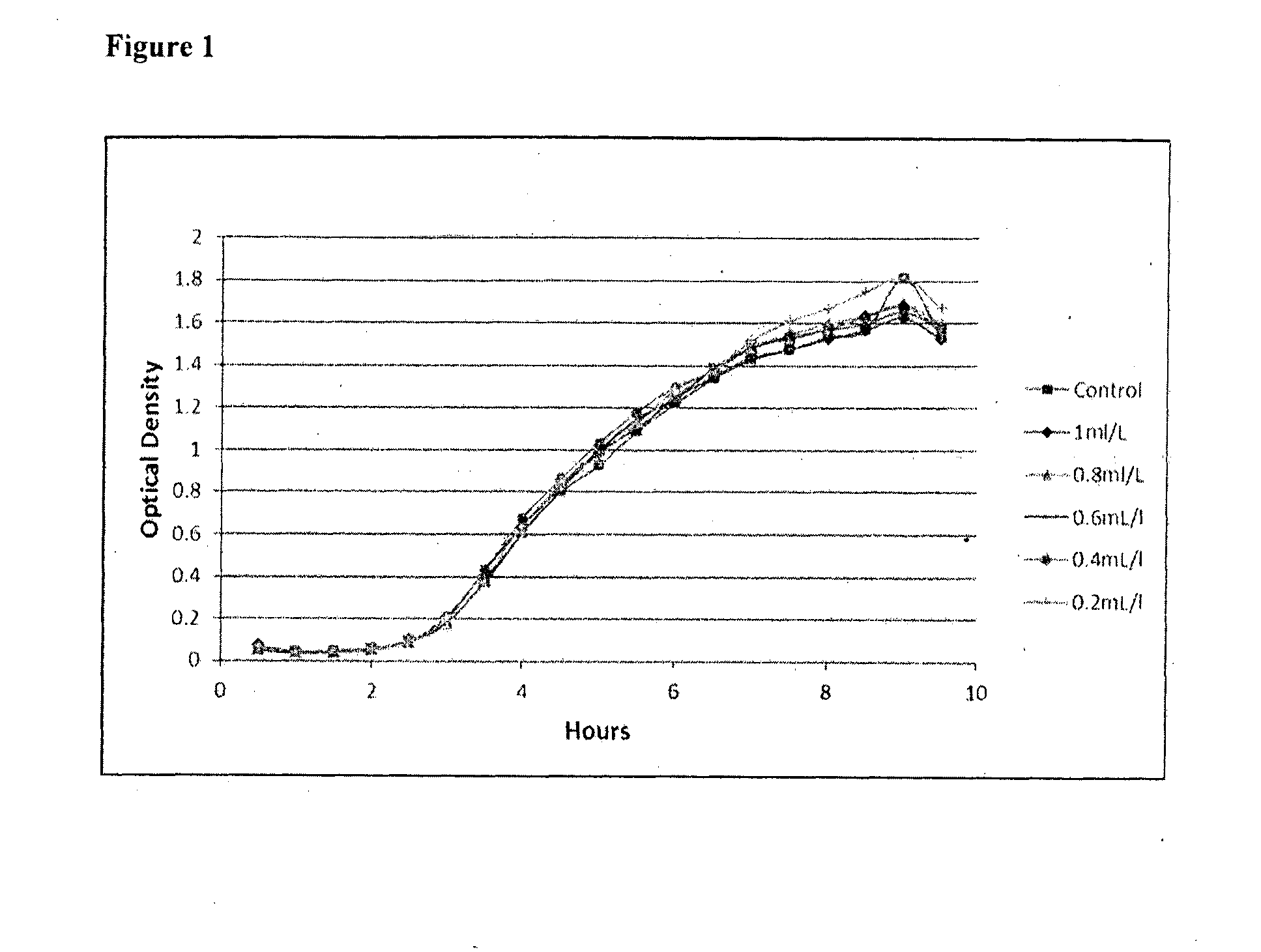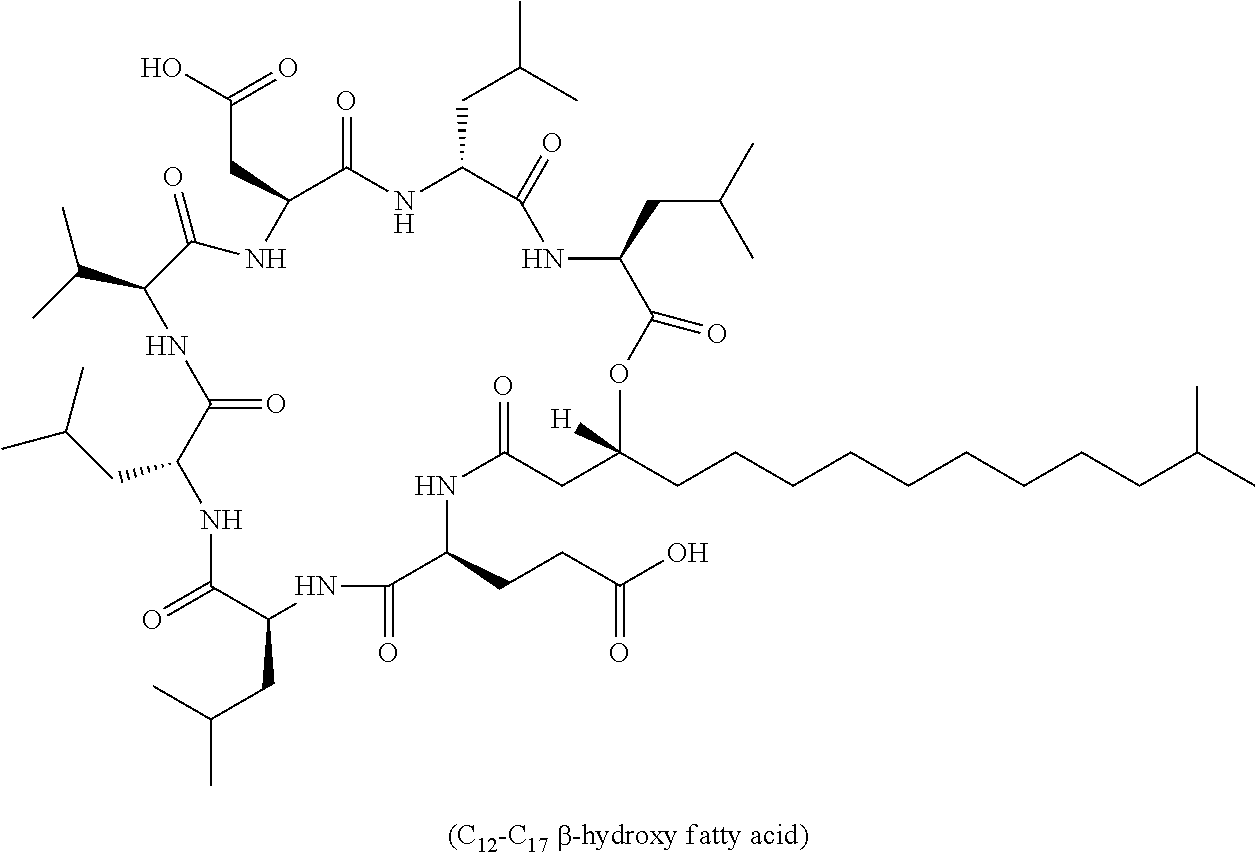Poultry farm practices
a poultry farm and farm technology, applied in the field of poultry farming facilities, can solve the problems of slow feeding, low weight, disease in the poultry population, etc., and achieve the effects of improving the environment, improving the environment, and improving the environmen
- Summary
- Abstract
- Description
- Claims
- Application Information
AI Technical Summary
Benefits of technology
Problems solved by technology
Method used
Image
Examples
example 1
Production of Surfactin Biosurfactant
[0099]Bacillus subtilis NRRL B-3383 strain (originally obtained from the United States Department of Agriculture) from bacterial culture was transferred at a 2% volume by volume inoculum into 4 L shake flasks containing 2.5 L of 10% vinasse based MMS broth. The vinasse based MMS broth containing:
componentquantityvinasse100mLammonium nitrate4.1gsodium phosphate dibasic5.68gtetrasodium tetrahydrate EDTA1.8mgmanganese sulfate6.8mgautoclaved deionized waterto 1L
[0100]The flasks were placed on orbital shakers (SKC 6100, Jeio Tech) at 150 rpm while incubating at 30° C. (MCO-801C Incubator, Sanyo). After 72 hours, flasks were removed from the incubator and the biomass removed from the crude culture broth by centrifugation at 8,500 rpm for 20 min at 4° C. (Sorvall Evolution RC).
[0101]The pH of the resulting supernatant was brought to a pH of 2.0 using HCl which resulted in precipitation of surfactin and the supernatant stored overnight at 4° C. to ensure...
example 2
Production of Blends of Surfactin and Lichenysin
[0104]Bacillus subtilis and Bacillus licheniformis were used to inoculate 4 L shake flasks containing 10% molasses based MMS broth. The molasses based MMS broth containing:
componentquantitymolasses100mLammonium nitrate4.1gsodium phosphate dibasic5.68gtetrasodium tetrahydrate EDTA1.8mgmanganese sulfate6.8mgautoclaved deionized waterto 1L
[0105]The flasks were placed on orbital shakers (SKC 6100, Jeio Tech) at 150 rpm while incubating at 30° C. (MCO-801C Incubator, Sanyo). After 72 hours, flasks were removed from the incubator and the biomass removed from the culture broth by centrifugation at 8,500 rpm for 20 min at 4° C. (Sorvall Evolution RC).
example 3
[0106]In a 1 liter bioreactor a buffer solution was prepared containing 800 mL demineralized water, monopotassium phosphate (20.4 g), disodium phosphate (28.4 g) and yeast extract (5 g). The buffer was mixed and the pH adjusted to 7. The buffer was then autoclaved. In a 1 L bioreactor, 200 mL of the buffer solution was mixed with magnesium sulfate (2 mL of 12 g / 100 mL solution), calcium chloride (1 mL, 0.1 M), ferrous sulfate heptahydrate (1 mL, 15.7 g / 100 mL solution), manganese sulfate monohydrate (1 mL, 3.8 g / 100 mL solution), sodium EDTA (1 mL, 0.18 g / 100 mL solution) and glucose (20 mL, 20 g / 80 g deionized water) and ammonium nitrate (10 mL, 82 g / 200 mL solution). Bacillus species spores were inoculated into the bioreactor at 2% wt. The biomass was agitated at 300 rpm for 12 hours at 35° C. The Bacillus was incubated until the cell density was to 1×1014 cfu per mL and the OD600 nm was 2.2.
PUM
| Property | Measurement | Unit |
|---|---|---|
| Density | aaaaa | aaaaa |
| Density | aaaaa | aaaaa |
| Density | aaaaa | aaaaa |
Abstract
Description
Claims
Application Information
 Login to View More
Login to View More - R&D
- Intellectual Property
- Life Sciences
- Materials
- Tech Scout
- Unparalleled Data Quality
- Higher Quality Content
- 60% Fewer Hallucinations
Browse by: Latest US Patents, China's latest patents, Technical Efficacy Thesaurus, Application Domain, Technology Topic, Popular Technical Reports.
© 2025 PatSnap. All rights reserved.Legal|Privacy policy|Modern Slavery Act Transparency Statement|Sitemap|About US| Contact US: help@patsnap.com


